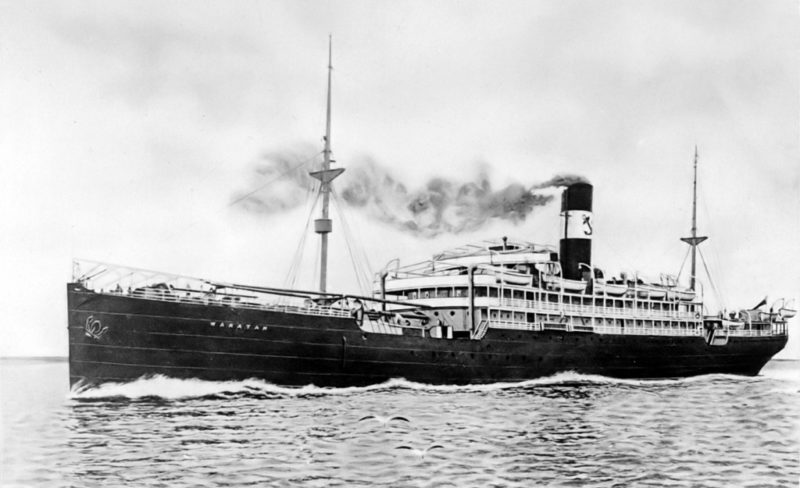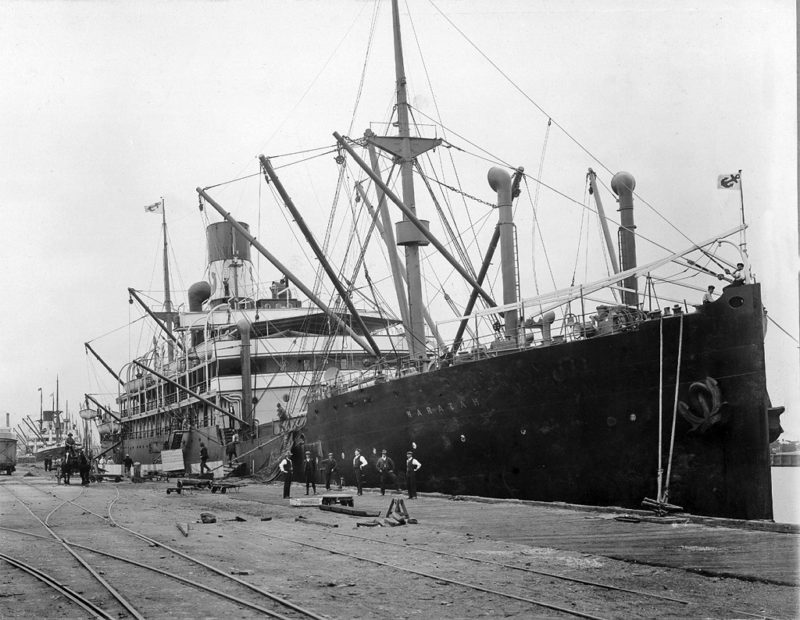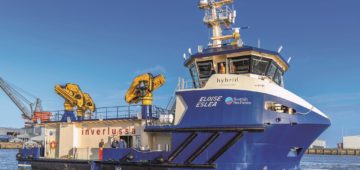The Loss of the Waratah in 1909

If you are an ex-seafarer, you will, at some time, probably been aware of various superstitions, especially relating to ship names, sailing on certain days of the week, killing an Albatross that follows a ship, to name but a few of many.
The Waratah which is the beautiful, adopted flower emblem for the Australian State of New South Wales, seems to fall into that unlucky category, since four ships bearing the name were lost.
One ship of that name had been lost off Ushant in the English Channel in 1848, one in 1887 on a voyage to Sydney, another south of Sydney, and one in the Gulf of Carpentaria in 1897. Then there is the most recent which was a fairly new steamship, only on her second voyage, which disappeared without trace off the Natal coast of South Africa. A possible last sighting of her was reported on 28th July 1909, but she failed to meet her scheduled arrival at Cape Town on 29th July. No trace of her was ever found, making her the fifth vessel to be lost bearing the name Waratah.
W.Lund & Sons, owners of the Blue Anchor Line placed an order in September 1907 with Barclay, Curle and Co. Ltd., of Glasgow, for a new cargo and passenger vessel specifically designed for their Blue Anchor Line to operate between Europe and Australia.
She was a fine modern cargo liner for her day designed specially for the UK, South Africa, Australia trade, to supplement Blue Anchor Line’s existing steamship SS Geelong. She had twin 4 Cylinder quadruple expansion steam reciprocating engines developing 1003 Nhp with service speed of 13.5 knots. She had 432 Cabin Berths, plus over 600 spaces in dormitories in the holds. The ship also featured cellular Double Bottom tanks over her entire length.
Waratah had three complete decks, lower, main and promenade. The first-class accommodations were built on the promenade, bridge and boat decks and could house 128 passengers. Third-class passenger accommodation was located on the poop deck and could accommodate upward of 300, although certified for only 160. Waratah was constructed with both speed and luxury in mind, and boasted eight state rooms, a salon whose panels depicted its namesake flower, as well as a luxurious music lounge complete with a musicians gallery.
The ship was also designed to be used as an emigrant ship on her outbound voyages from Europe, hence her cargo holds would be converted into large dormitories capable of holding almost 600 or more steerage passengers, while on the return the ship would be laden with general cargo, mainly frozen meat, dairy products, and bales of wool, as well as ore from Australia. In order to be able to carry frozen produce, her entire forward cargo comparments were fitted with refrigerating machinery and cold chambers. She also had a fresh water distilling plant, capable of producing 25,000 litres of fresh water per day. At the time of her construction, Waratah was not equipped with a WT radio, which was normal at the time, as marine radio was still in its development stage and thus, was not mandatory. She did however have lifeboat and raft capacity for 921 persons.
Following her sea trials and acceptance by the owners, Waratah departed from London for her maiden voyage on 5th November 1908 with 689 third-class and 67 first-class passengers and crew of 154. She proceeded via the Cape of Good Hope, calling at Cape Town on 27th November and then direct to Adelaide where she arrived on 15th December 1908. From Adelaide the ship proceeded to Melbourne and Sydney and sailed back for London on 9th January 1909 via Australian, and South African ports, carrying a cargo of mainly foodstuffs, wool in bales, and 1,500 tons of metal concentrates.
Her maiden voyage was largely uneventful except for a small fire which broke out in the lower starboard bunker on the 6th December, which extended all the way to the engine room. It was extinguished but did re-ignite from time to time until 10th December. Waratah subsequently arrived in London on 7th March 1909 at the completion of her maiden voyage, and after unloading her cargo, was drydocked where she was inspected by the Lloyds surveyor, and underwent some minor repairs.
As is standard practice with most new ships, during her maiden voyage the ship was probed and scrutinized by the Officers and crew for any obvious defects. The captain reported he had concerns with the vessel’s stability characteristics. He was especially concerned with the requirement to properly load the steamer to maintain her stability. This resulted in a conflict between the owners and the builders following the vessel’s return to England. The subsequent court of inquiry into her loss raised some disputed reports of instability on this voyage.

On 27th April 1909 Waratah set out on her second trip to Australia carrying 22 cabin, 193 steerage passengers in addition to a large amount of general cargo, with a crew of 119. The outward trip was mainly uneventful, and the steamer arrived at Adelaide on 6th June after calling at Cape Town on 18th May.
Having loaded approximately 970 tons of lead ore at Adelaide, the ship continued her passage to Melbourne, having encountered adverse weather en route, arriving there on 11th June. She then continued to Sydney where she loaded her cargo for the return voyage, consisting mainly of bagged flour, bales of wool, dairy products, frozen meat, and 7,800 bars of bullion. She then departed on 26th June bound for Melbourne and Adelaide to complete her loading for Europe, finally departing Adelaide on 7th July bound for South African ports prior to continuing the voyage via the Cape of Good Hope, to Europe. She was also carrying 100 passengers. Her crossing of the Indian Ocean was uneventful, and she arrived at Durban on the morning of 25th July.
The Waratah departed from Durban on the evening of 26th July with 211 passengers and crew. At around 0400 hours on 27th July she was sighted astern on the starboard side by the Clan Line steamer Clan MacIntyre. As the Waratah was faster than the Clan MacIntyre she eventually overtook her. However, before dropping out of sight both vessels made visual communication by Aldis lamp, and exchanged customary information about the name and destination of their respective ships.
Waratah, steaming at approximately 13 knots, overtook Clan MacIntyre when abeam of the mouth of the Bashee River on the southeast coast of Natal. Waratah remained in sight of Clan MacIntyre, gradually steaming away until she disappeared over the horizon by about 0930. This was the final confirmed sighting of Waratah. Later that day the weather deteriorated quickly with increasing wind and rough seas. This had developed into a cyclone by 28th July. The captain of the Clan MacIntyre said it was the worst weather he had experienced at sea in his 13 years as a seafarer, with winds of exceptional strength causing tremendous seas. There were several other unconfirmed sightings of the Waratah.
At around 1730 on the 27th, a ship called the Harlow saw the smoke of a steamer on the horizon. There was so much smoke that her captain wondered if the steamer was on fire. When darkness fell, the crew of the Harlow could see the steamer’s running lights approaching, but still some 10 to 12 miles distance astern of them. Suddenly there were two bright flashes from the direction of the steamer and the lights vanished. The captain thought they were caused by explosions but the chief mate of the Harlow, who had also seen them, thought the flashes were bush fires on the shore. The captain agreed and did not enter the events in the log, only when he learnt of the disappearance of the Waratah did he think the events significant.
That same evening at around 2130 hours the Union-Castle Liner Guelph, heading north to Durban from the Cape of Good Hope, passed a ship and exchanged signals by Aldis Lamp, but because of the bad weather and poor visibility was able to identify only the last three letters of her name as “T-A-H”.
Another possible sighting, which was not disclosed to the Inquiry at the time, was by two Cape Mounted Rifelman who on 28th July 1909, were posted to carry out military exercises on the banks of the mouth of the Xora River. They recorded in their diary that they had observed through a telescope a steamship which matched the description of the Waratah that appeared to be heading in a southwesterly direction and was grappling against heavy seas. The ship was observed to roll heavily to starboard, and then before it was able to right itself, a following wave rolled over the ship, which then disappeared from view, leading them to believe it had gone under. They reported their sightings to their base camp and to their Orderly Sergeant, who apparently did not take the matter seriously. He did not come forward with his story until 1929.
The Waratah had been expected to reach Cape Town on 29th July 1909, but never reached its destination. No trace of the ship has ever been found. Initially, the non-arrival of the ship did not cause alarm as it was not uncommon in those days for ships to arrive at port days, or occasionally even weeks overdue. It was at first thought likely that she had been delayed by a breakdown or mechanical fault and was still adrift. Fears started to grow for her safety, when other ships which had left Durban after Waratah following a similar course began arriving at Cape Town and reported having seen no sign of her en-route.
Search efforts commenced on 1st August with the tug T.E. Fuller, but she was forced to return due to very bad weather, later returning to search along the coast. The Royal Navy dispatched three cruisers, the Pandora, Forte and Hermes to search for her but to no avail, and they were forced to return to port. The Hermes when in the area where the Waratah was last sighted encountered such severe weather that she sustained hull damage, which required her to be drydocked for repair. On the 10th August a signal was received stating the Waratah had been sighted, but it turned out to be a false alarm.
Numerous other vessels joined the search for the Waratah, on 13th August 1909 the steamship Insizwa reported sighting several bodies off the mouth of Mbashe River, near the location of the last confirmed sighting of the Waratah. The captain of the Tottenham also allegedly saw bodies in the water, more than two weeks after the Waratah disappeared. The tug Harry Escombe was dispatched to search for the bodies but was unable to locate any.
Hopes were held that the Waratah was perhaps, broken down and drifting unable to make contact, so in September 1909, the Blue Anchor Line chartered the Union Castle cargo ship Sabine to search for the Waratah. The Sabine was specially equipped with powerful search lights and other equipment. Its search covered 14,000 nautical miles which zig-zagged across the anticipated drift path of the Waratah but yielded no result. On 15th December 1909 the Waratah was officially declared missing. However, a subsequent search was conducted by the Wakefield early in 2010, lasting for four months and covered 15,000 miles, but yielded a negative result.
No confirmed wreckage or bodies from the Waratah have ever been located or recovered, although there were a number of unconfirmed reports, such as wreckage reported to have been found at Mossel Bay in March 1910, a life jacket reportedly marked with the name Waratah washed up on the coast of New Zealand in February 1912, and in 1925 a South African Air Force pilot reported that he had spotted a wreck while he was flying over the Transkei coast. It was his opinion that this was the wreck of the Waratah. Pieces of cork and timber, possibly from the Waratah, were washed up near East London, South Africa in 1939.





Comments
Sorry, comments are closed for this item